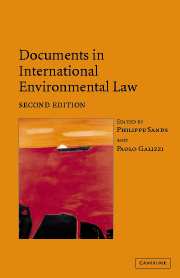Book contents
- Frontmatter
- Contents
- Preface
- PART I General instruments
- PART II Atmosphere
- PART III Oceans: global
- PART IIIB Oceans: regional
- PART IV Freshwater resources
- 14 Convention on the Protection and Use of Transboundary Watercourses and International Lakes, 17 March 1992
- 14A Protocol on Water and Health to the 1992 Convention on the Protection and Use of Transboundary Watercourses and International Lakes, 17 June 1999
- 15 United Nations Convention on the Law of the Non-Navigational Uses of International Watercourses, 21 May 1997
- PART V Biodiversity
- PART VIA Hazardous substances and activities: nuclear
- PART VIB Hazardous substances and activities: pesticides
- PART VIC Hazardous substances and activities: waste
- PART VII Human rights and the environment
- PART VIII War and the environment
- PART IX Trade and the environment
- PART X Environmental impact assessment and access to information
- PART XI Liability for environmental damage and breaches of environmental obligations
- PART XII The Antarctic
14 - Convention on the Protection and Use of Transboundary Watercourses and International Lakes, 17 March 1992
Published online by Cambridge University Press: 05 June 2012
- Frontmatter
- Contents
- Preface
- PART I General instruments
- PART II Atmosphere
- PART III Oceans: global
- PART IIIB Oceans: regional
- PART IV Freshwater resources
- 14 Convention on the Protection and Use of Transboundary Watercourses and International Lakes, 17 March 1992
- 14A Protocol on Water and Health to the 1992 Convention on the Protection and Use of Transboundary Watercourses and International Lakes, 17 June 1999
- 15 United Nations Convention on the Law of the Non-Navigational Uses of International Watercourses, 21 May 1997
- PART V Biodiversity
- PART VIA Hazardous substances and activities: nuclear
- PART VIB Hazardous substances and activities: pesticides
- PART VIC Hazardous substances and activities: waste
- PART VII Human rights and the environment
- PART VIII War and the environment
- PART IX Trade and the environment
- PART X Environmental impact assessment and access to information
- PART XI Liability for environmental damage and breaches of environmental obligations
- PART XII The Antarctic
Summary
Editorial note
The object of the Convention on the Protection and Use of Transboundary Watercourses and International Lakes, adopted under the auspices of the UNECE, is to protect the environment from adverse effects of human use of transboundary water. The basic obligations are to ‘take all appropriate measures’ to achieve the following objectives: prevention, reduction and control of pollution; use of transboundary waters in a manner which conforms with ‘ecologically sound and rational water management’; use of transboundary waters that is ‘reasonable and equitable’; and conservation and restoration of ecosystems (Article 2(2)). Pollution prevention, reduction and control measures should be taken at source (Article 2(3)) and should not result in the transfer of pollution to other sectors of the environment (Article 2(4)). The guiding principles underlying the chosen measures are the ‘precautionary principle’, the ‘polluter-pays principle’ and the interests of future generations (Article 2(5)). Parties are specifically entitled to take measures stricter than those required by this Convention (Article 2(8)).
In particular, the Convention outlines several means by which its objectives can be met, including the following: application of ‘non-waste technology’; licensing and control of waste water discharges based on ‘best available technology’; biological treatment of municipal waste water, or an equivalent substitute; application of ‘best available technology’ and ‘best environmental practices’ for land-based sources of pollution; environmental impact assessment; and minimisation of risk of accidental pollution (Article 3(1)). ‘Best available technology’ is defined in Annex I to the Convention and guidelines on ‘best environmental practices’ are set out in Annex II.
- Type
- Chapter
- Information
- Documents in International Environmental Law , pp. 539 - 557Publisher: Cambridge University PressPrint publication year: 2004



